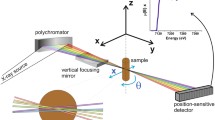Abstract
Archaeological bone materials record characteristic markers of life in prehistoric times (dating, climate, environment, diet, human migration) in their isotopic and chemical composition in addition to palaeontological, archaeozoological, anthropological and palaeogenetic information. Thus, the discovery and conservation of archaeological bone materials is of great importance to get access to this information. However, archaeological materials are altered by different postmortem processes and it appears necessary to estimate if the archaeological information is still reliable or if it has been modified during burial. As archaeological bone materials present a high structural hierarchy at the micro- and nanoscale, changes induced by diagenetic phenomena have to be observed at these scales. One method for revealing post mortem changes of the bone structure and composition at the microscale is synchrotron radiation micro-FTIR imaging (SR micro-FTIR). Thus, thin sections of about 5,000-year-old archaeological bones have been analysed in transmission mode at the IRIS beamline (BESSY II, HZB Berlin) to determine markers of the state of bone preservation at the microscale. The archaeological bone material comes from station 19 of the Neolithic site of the Chalain Lake. By using SR micro-FTIR it was possible to image characteristic bone structures, e.g. osteons (the constitutive histological unit of cortical bone), using the absorption band ratios corresponding to different chemical bone constituents (collagen content and quality, phosphate crystallinity, carbonate content). These data allow us to precisely evaluate the state of preservation of a 5,000-year-old bone at the histological level.

Chemical mapping of a thin section of the archaeological bone AB_CH19nb1 from the Neolithic station 19 at Chalain Lake






Similar content being viewed by others
References
Bocherens H, Drucker DG et al (2006) Bears and humans in Chauvet Cave (Vallon-Pont-d’Arc, Ardèche, France): insights from stable isotopes and radiocarbon dating of bone collagen. J Hum Evol 50:370–376
Kutschera W, Müller W (2003) “Isotope language” of the Alpine Iceman investigated with AMS and MS. Nucl Instrum Meth Phys Res B 204:705–719
Price TD, Burton JH et al (2002) The characterization of biologically available strontium isotope ratios for the study of prehistoric migration. Archaeometry 44(1):117–135
Hedges REM (2002) Bone diagenesis: an overview of processes. Archaeometry 44(3):319–328
Wilson L, Pollard M (2001) Here today, gone tomorrow? Integrated experimentation and geochemical modeling in studies of archaeological diagenetic change. Acc Chem Res 35(8):644–651
Smith CI, Nielsen-Marsh CM et al (2007) Bone diagenesis in the European Holocene I: patterns and mechanisms. J Archaeol Sci 34:1485–1493
Currey JD (2002) Bones. Princeton University Press, p 456
Reiche I, Favre-Quattropani L et al (2003) A multianalytical study of bone diagenesis: the Neolithic site of Bercy (Paris, France). Meas Sci Technol 14:1608–1619
Weiner S, Bar-Yosef O (1990) States of preservation of bones from prehistoric sites in the Near East: a survey. J Archaeol Sci 17:187–196
Grupe J (1995) Preservation of collagen in bone from dry, sandy soil. J Archaeol Sci 22:193–199
Bartsiokas A, Middleton AP (1992) Characterization and dating of recent and fossil bone by x-ray diffraction. J Archaeol Sci 19:63–72
Koon HE, O'Connor C et al (2010) Sorting the butchered from the boiled. J Archaeol Sci 37:62–67
Boskey A, Camacho NP (2007) FT-IR imaging of native and tissue-engineered bone and cartilage. Biomaterials 28:2465–2478
Chadefaux C, Le Hô A-S et al (2009) Micro-ATR-FTIR studies combined with the curve-fitting of the amide I and II bands of type I collagen in archaeological bone materials. ePreservSci 6:129–137
Fratzl P, Paris O (2004) Complex biological structures: collagen and bone. In: Fitter J, Gutberlet T, Katsaras J (eds) Neutrons in biology—techniques and applications. Springer, Heidelberg, pp 15–34
Gupta HS, Seto J et al (2006) Cooperative deformation of mineral and collagen in bone at the nanoscale. PNAS 103(47):17741–17746
Miller L, Dumas P (2006) Chemical imaging of biological tissue with synchrotron infrared light. Biochim Biophys Acta 1758:846–857
Petrequin P (ed) (1997) Les sites littoraux néolithiques de Clairvaux-Les-Lacs et de Chalain (Jura) III Chalain station 3 3200–2900 av. J.-C. Paris, Maison des Sciences de l'Homme
Paschalis EP, Verdelis K et al (2001) Spectroscopic characterization of collagen cross-links in bone. J Bone Miner Res 16(10):1821–1828
Ruppel ME, Burr DB et al (2006) Chemical makeup of microdamaged bone differs from undamaged bone. Bone 39:318–324
Rey C, Renugopalakrishnan V et al (1991) Fourier transform infrared spectroscopic study of the carbonate ions in bone mineral during aging. Calcif Tissue Int 49:251–258
Trueman CNG, Behrensmeyer AK et al (2009) Why do crystallinity values fail to predict the extend of diagenetic alteration of bone mineral? Palaeogeogr Palaeoclimatol Palaeoecol 266(3–4):160–167
Reiche I (2009) Hétérogénéités de la composition chimique et de la structure des ossements archéologiques provenant du site néolithique de Chalain 19 (Jura, France) induites par la chauffe et la diagenèse. Palethnologie 2:16
Acknowledgements
The authors thank Pierre Pétrequin (Laboratoire Chrono-environnement UMR 6249, Besançon, France) for providing archaeological samples and Paul Dumas (SMIS Beamline, SOLEIL, Paris, France) for helping us with BaF2 pellets as well as Peter Lasch for his help with CytoSpec. Danielle Jaillard (CCME UMR 8080, Orsay, France) is also acknowledged for her advice during sample preparation. This work was supported by the EU project R II 3.CT-2004-506008, the BESSY project ID.09.1.80792 and the ANR project No. ANR-07-JCJC-0149-01.
Author information
Authors and Affiliations
Corresponding author
Rights and permissions
About this article
Cite this article
Reiche, I., Lebon, M., Chadefaux, C. et al. Microscale imaging of the preservation state of 5,000-year-old archaeological bones by synchrotron infrared microspectroscopy. Anal Bioanal Chem 397, 2491–2499 (2010). https://doi.org/10.1007/s00216-010-3795-4
Received:
Revised:
Accepted:
Published:
Issue Date:
DOI: https://doi.org/10.1007/s00216-010-3795-4




